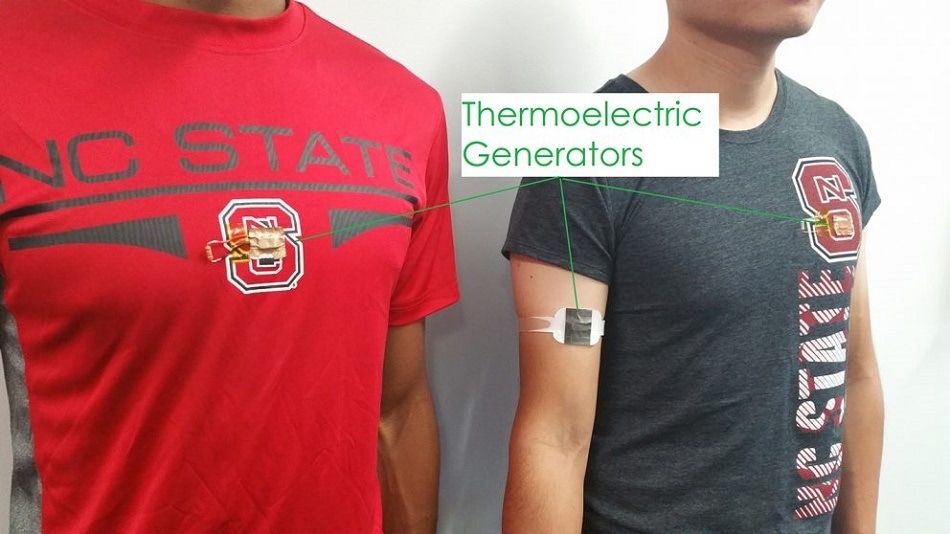Sep 13 2016
 TEG-embedded T-shirt (left) and TEG armband (right)(Image Credit: Daryoosh Vashaee)
TEG-embedded T-shirt (left) and TEG armband (right)(Image Credit: Daryoosh Vashaee)
A team of researchers from North Carolina State University have created a new design to harvest the heat generated by the body, and change it into electricity to be used in wearable electronics. The experimental models are lightweight, match the shape of the body, and can produce a lot more electricity than previous lightweight heat harvesting technologies.
The team has also identified the best possible site on the body for heat harvesting.
Wearable thermoelectric generators (TEGs) generate electricity by making use of the temperature differential between your body and the ambient air. Previous approaches either made use of heat sinks – which are heavy, stiff and bulky – or were able to generate only one microwatt or less of power per centimeter squared (µW/cm2). Our technology generates up to 20µW/cm2 and doesn’t use a heat sink, making it lighter and much more comfortable.
Daryoosh Vashaee, Associate Professor, North Carolina State University
The innovative design has a layer of thermally conductive material that makes contact with the skin and disperses the heat. A polymer layer tops the conductive material to prevent the heat from escaping into the atmosphere.
This forces the body heat to pass via a centrally-located TEG that is 1 cm2. Heat that is not converted into electricity moves through the TEG into an outer layer of thermally conductive material, which quickly dissipates the heat. The whole system is thin - only 2 mm - and flexible.
In this prototype, the TEG is only one centimeter squared, but we can easily make it larger, depending on a device’s power needs.
Daryoosh Vashaee, Associate Professor, North Carolina State University
Vashaee worked on the project as part of the National Science Foundation’s Nanosystems Engineering Research Center for Advanced Self-Powered Systems of Integrated Sensors and Technologies (ASSIST) at NC State.
The team also discovered that the upper arm was the most favorable location for heat harvesting. Although the skin temperature of wrist is higher, the wrist’s irregular contour restricts the surface area of contact between the skin and the TEG band.
Wearing the band on the chest restricted air flow - restricting heat dissipation - as the chest is usually covered by a shirt.
Additionally, the researchers integrated the TEG into T-shirts. The team found that the T-shirt TEGs could generate 6 µW/cm2 – or as much as 16 µW/cm2 if a person was running.
T-shirt TEGs are certainly viable for powering wearable technologies, but they’re just not as efficient as the upper arm bands. The goal of ASSIST is to make wearable technologies that can be used for long-term health monitoring, such as devices that track heart health or monitor physical and environmental variables to predict and prevent asthma attacks. To do that, we want to make devices that don’t rely on batteries. And we think this design and prototype moves us much closer to making that a reality.
Daryoosh Vashaee, Associate Professor, North Carolina State University
The research paper titled, “Wearable thermoelectric generators for human body heat harvesting,” is published in the Applied Energy journal. Lead authors of the paper are Melissa Hyland, a graduate student at NC State, and Haywood Hunter, an undergraduate at NC State.
They worked on the project while undergraduates, with support from an NSF Research Experiences for Undergraduates grant. Co-authors include Jie Liu, a postdoctoral researcher at NC State; and Elena Veety, education director of ASSIST at NC State. The research was funded by the NSF under grants EEC-1160483, ECCS-1351533 and CMMI-1363485; and by the Air Force Office of Scientific Research under grant FA9550-12-1-0225.